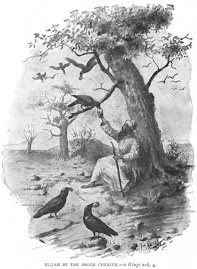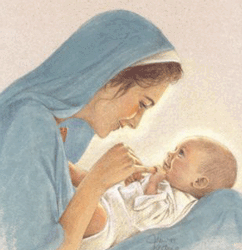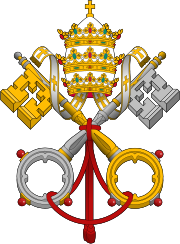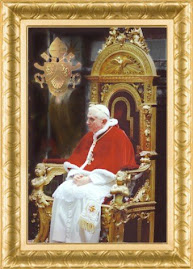FEAST OF SEVEN SORROWS OF OUR LADY
"On the Seventh Dolour - The Burial of Jesus"
fragments from "Victories of the Martyrs" by St. Alphonsus Liguori
When a mother is by the side of her suffering and dying child, she undoubtedly suffers and feels all his pains; but after he is actually dead, when, before the body is carried to the grave, the afflicted mother must bid her child a last farewell; then, indeed, the thought, that she is to see him no more, is a grief that exceeds all other griefs. That we may better understand this last sorrow. We will return to Calvary and consider the afflicted mother who still holds the body of her lifeless son, clasped in her arms. O my Son, she seemed to say, in the words of Job "Thou art changed to be cruel towards me" (Job 30:21). Yes, for all thy noble qualities, thy beauty, grace and virtues, thy engaging manners, all the marks of special love you have bestowed upon me, all the particular favours you have bestowed upon me are no changed into grief. As so many arrows have pieced my heart, and the more they have caused me to love thee, the more they have caused me to feel thy loss.
Taken from: "The Servite Manual: BEHOLD THY MOTHER - a Collection of Devotions Chiefly in Honor of Our Lady of Sorrows," compiled by The Servite Fathers.
In 1242, Ardingo, Bishop of Florence, having ordered a general procession in his Episcopal city to implore the cessation of the troubles then affecting the Church, and having invited the Seven Holy Founders to take part therein, infants once again were constrained by a supernatural impulse to cry: "Behold the Servants of Mary." Two years later, in 1244, when St. Peter of Verona came to Florence to combat the heresy of the Patarines, Mary, several times, when he was praying, showed him in a vision a high mountain covered with fair flowers, amidst which were seven lilies, dazzling white, of exquisite perfume. Angels descended from heaven to gather these flowers and weave them into garlands, which she graciously accepted, above all the seven lilies, which were her peculiar choice. This mountain, as Mary herself explained to St. Peter, represented Mount Senario; the flowers were the religious who dwelt thereon, the seven lilies the seven first Fathers. "All these flowers," she said, "are precious and dear to me, but the seven lilies are precious above all, and are my favorite flowers. I and I only have planted and nurtured them for my special delight, and I desire that thou treat with veneration and honor those whom I so highly esteem." At another time she appeared to the holy Martyr clad all in black, covering with her large mantle Religious in the same habit, among whom he recognized St. Bonfil and St. Alexis, and said to him: "Know, Peter, my beloved son, that these Religious are my Servants. I have chosen them from among men, and honored them with that title, that they may serve me in a special manner. They are dedicated to me, and their Order is founded by me and for me."
To so many testimonies of her love Mary added yet another, which was to last through the ages, even to our own days. This was her miraculous picture of the Annunciation in the Servite Church at Florence, hence called the Virgin of the Annunciation. In 1252, St. Bonfil and St. Alexis desired to have a beautiful picture of the most holy Virgin in their church, and confided the work to a painter named Bartolomeo. He succeeded in finishing the picture, with the exception of the face of the most holy Virgin, which he was unable to represent as he wished. Aware of his incompetence, he applied himself to prayer and the sacraments, and God rewarded his trust. During his absence an angel finished the fresco, painting the face of the most holy Virgin which is the admiration of all who see it. Graces without number at once bore witness to the miraculous origin of the sacred portrait, and made that church one of the most celebrated sanctuaries of Italy. Before that picture St. Philip, two years afterwards, had the vision wherein our Lady of Dolors exhorted him to enter her Order. The devotion which St. Aloysius Gonzaga bore to it is well known, and during his stay at Florence he allowed no day to pass without spending a time before it in prayer.In gratitude for favors so many and so great, the Holy Founders and their spiritual children worked everywhere with boundless zeal to extend the devotion to their heavenly Lady, and above all compassion for her Dolors. St. Philip Benizi followed in their steps, and during the eighteen years he was General of the Order he gave an extraordinary impulse both to the Order and the devotion of which it is the standard-bearer. Thus less than half a century after its foundation, thanks to the labors of the Founders, of St. Philip, and of their Religious, the devotion to our Lady of Dolors had been preached not only in Italy, but also in France, in Germany, on the shores of the North Sea, and throughout the vast regions of Poland. The work so well begun by the Holy Founders and St. Philip was zealously continued by their successors, especially in the sixteenth and seventeenth centuries, during which this beautiful devotion had an extraordinary development. Many illustrious persons asked for and received the Black Scapular, out of love for the Mother of Dolors. According to some authors, St. Louis and Philip the Bold in France, and the Emperor Rudolph of Hapsburg in Germany, received it from the hands of the Holy Founders and St. Philip; but there is no certainty about this matter. In the fourteenth century a zealous religious, Fr. Luke of Prato, preached in Spain, and gave the scapular to Ferdinand, King of Portugal, and many princes of his court; to Henry, King of Castille; Peter IV, King of Aragon; and John, King of Navarre. In Germany the Emperor, Charles IV and his consort the Empress Anne received it, and shortly afterwards, Ladislas IV in Poland. But among all those who were distinguished by their devotion towards our Lady of Dolors, must be named, in the sixteenth century, Philip I, King of Spain and Archduke of Austria, who, wishing to remedy the troubles which desolated Flanders, there instituted the Confraternity of the Seven Dolors, and had the consolation of seeing those troubles soon brought to an end. The Emperors Maximilian, Ferdinand, Matthias, Leopold, and others of the house of Austria continued this holy tradition of devotion to our Lady of Dolors and the Order founded by her. In 1734, the Emperor Charles VI requested that the Feast of our Lady of Dolors in September should be extended to all his states, and his example was followed in the following year by Philip V for Spain. Anna Juliana, Archduchess of Austria, who reestablished the Servite Order in Germany, considered this devotion so salutary to her soul that she retired as a tertiary with her daughter into one of the three convents she had herself built in Innsbruck and frequently remarked that she considered the wearing of the scapular as above privileges of wealth and exalted rank. So great was the esteem in which this pious princess held the holy habit of Our Lady of Dolors, that in order to receive it, she refused the nuptial alliance of the emperors Rudolph II and Matthias, and her daughter that of Philip III of Spain. Nor has this devotion slackened in our own days; on the contrary, it would appear to have gained a new impulse of late years, if we may judge from the many petitions addressed to the Right Reverend Father General of the Order for powers to establish the Confraternity and give the Scapular. At present a large number of Bishops and Cardinals not only belong to the Confraternity, but also to the Third Order, and manifest a great devotion to our Lady of Sorrows.
Now, owing doubtless to the sad times we are going through, Christian souls turn instinctively to Mary, the sorrowful Mother. Their pains are so like an echo to Mary's pains. In meditating on her sorrow, they find much relief and strength. The contemplation of the Passion of Christ is a fruitful source of spiritual help, nor can we ever know or understand His sufferings, as when we meditate on them in the company of His most Holy Mother. For no one in this world ever entered so deeply into those sorrowful mysteries. Houses of the Servite Order being established in England and America are so many means to help the development of that so Christian devotion to the Mother of Christ in English speaking countries.
Prayer
O sweet Virgin, made sad by our sins and former ingratitude to Jesus and to thee, to thee we turn, humbled and contrite that thou mayest show thy mercy towards us, as thou didst upon the seven glorious Saints called by thee to establish the Order of thy Servants. Yes make us thy true servants, make us serve Jesus faithfully, increase the number of thy faithful ones and their fidelity, that even as thy pains merited for thee the queenly diadem, so our affection for thee may entitle us to be thy happy subjects forever. Amen.
Text after Our Lady of the Rosary Library




























